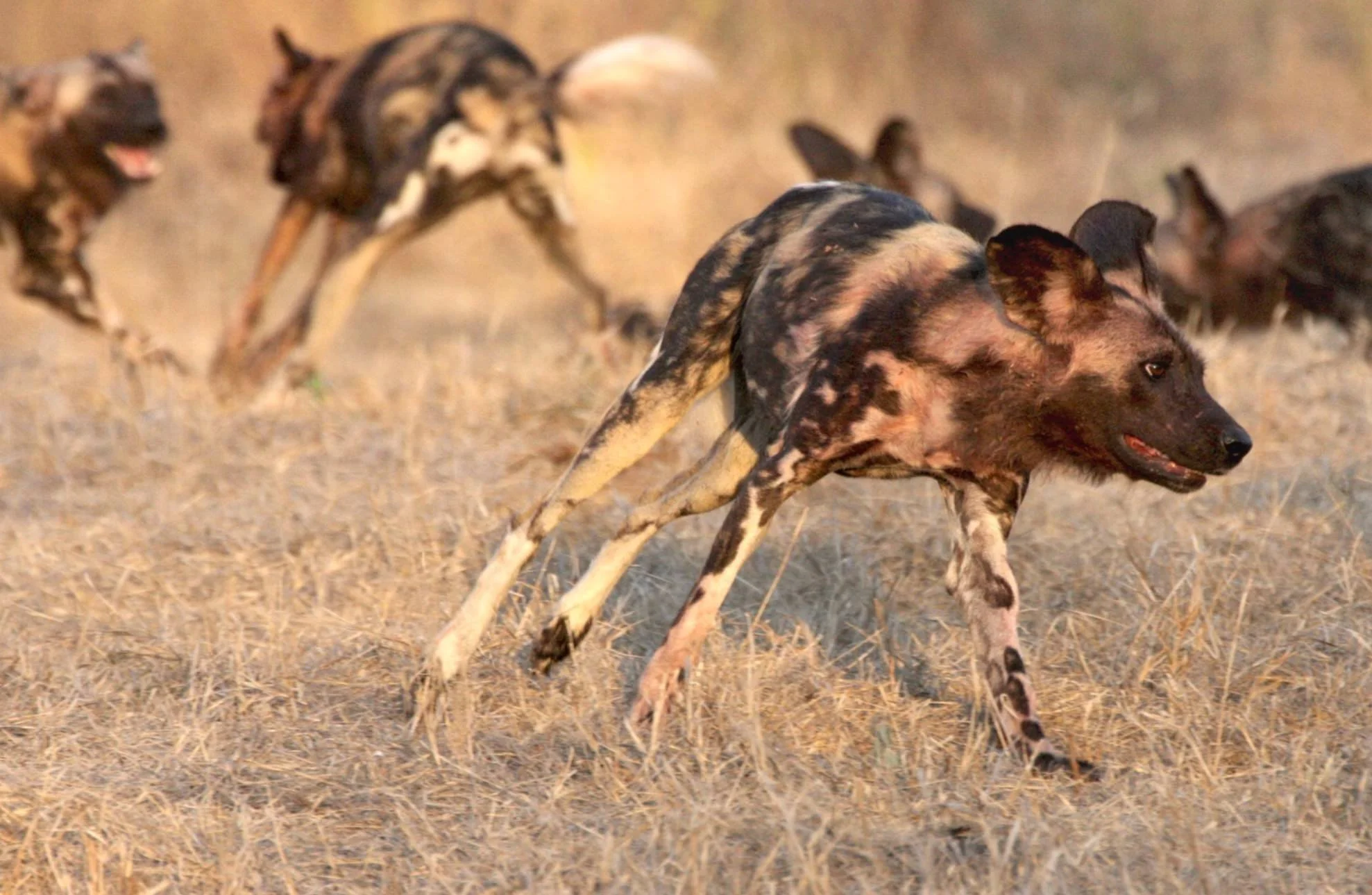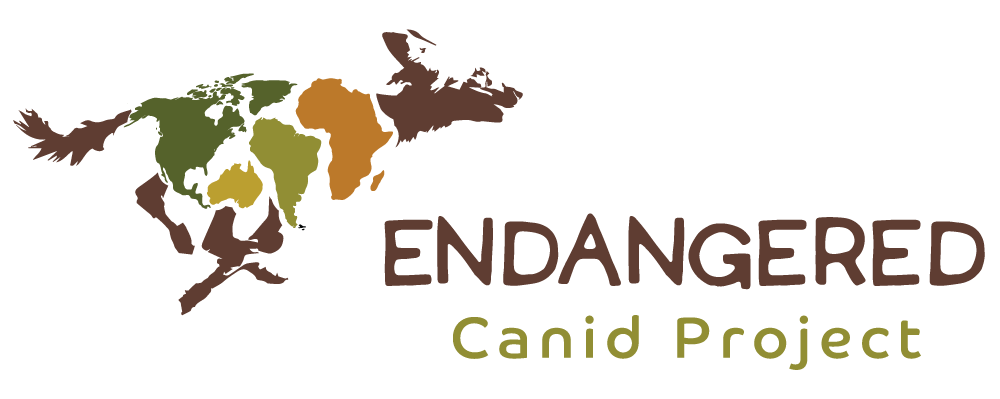african wild dogs/painted dogs



40 MILLION YEARS IN THE MAKING
African Wild or Painted dogs have a unique evolutionary line that can be traced back forty million years to a small carnivorous animal, Miacis, a distant relative of the modern-day civet. Approximately 30 million years ago, two other animals emerged: Daphaenus (or Bear Dog), which eventually evolved into our modern-day bears, and Cynodictus, an arboreal civet-like animal.
From Cynodictus, an animal called Temnocyon developed and from this mammal, the modern-day dogs of Africa (Lycaon pictus or Painted Dog), India (Cuon or Dhole) and South America (Speothos venaticus or South American Bush Dog) evolved.
Interestingly, wolves, dogs, and foxes evolved through a different lineage. Cynodesmus emerged in North America as huge hyena-like animals (though unrelated to hyenas). An offshoot from Cynodesmus called Tomarctus is the ancestor from which these other canids developed.
This explains the differing appearance between painted dogs and North American canids.
Painted dogs are one of the rarest species on the African continent.
All the Better to
Hear You With
One of the first things people notice about painted dogs is their large, rounded ears. Hearing plays a role in catching prey, but also in keeping the pack together. “Hoo” calls are used to contact individuals when pack members are separated and can carry over a mile.
Constantly communicating, dogs use quieter vocalizations to connect within the pack to avoid unwanted attention.
No TWo Dogs
Are alike
Each animal has a unique and distinctly patterned coat made up of black, dark brown, yellow, and white.
Their genus and species, Lycaon pictus, literally means “painted wolf-like animal.”
It takes
a village
Each pack is led by an alpha pair who primarily do all of the breeding, though in times of abundant resources, other animals have been known to breed. The alpha female selects and digs her den site, sometimes with the help of others in the pack. Often she will start with an abandoned aardvark or warthog hole. Pups are born mainly black with some white spots after a gestation period of 69-73 days. It is common for ten to twelve pups to be born. The entire pack nurtures the pups. While pups are still in the den, a babysitter or two will be left behind to care for the young while the pack is out hunting.
In this way, the entire pack rears the young and assures the success of their adults regurgitate food from the hunt for the pups until they are ready to join the pack on the hunt, typically after about six months. At this time, pups are always allowed first dibs at a kill, giving them the best chance for survival. This is an important time for the pups as they begin learning to hunt and the exercise helps their legs to grow long. Interestingly, researchers have discovered that pups born in zoos have legs that are noticeably shorter. Same-sex siblings leave their familial pack at about two and a half years of age, joining similar groups of the opposite sex. This is the only way in which young females would have the opportunity to breed.
All for One
and One for All
Extremely social animals, painted dogs live their lives in close association, depending on their pack members for survival. Successful packs are typically between 6-24 animals, but can be as small as two individuals with some success. A 3:1 ratio of dogs to lions, for example, is necessary for them to be able to defend their kill. A pack that is too small cannot defend easily, but a pack that is too big struggles to bring in enough food.
Pack allegiance is forged through robust social bonds and intricate ritual behavior. Prior to a hunt, the pack engages in what one researcher aptly describes as a ‘pep rally,’ a flurry of running, playing, and mutual greetings that precede the hunt. A similar spectacle unfolds upon a pack’s reunion, with each member warmly acknowledging the others.
Painted dogs are one of the few examples of an animal that cares for their sick and elderly. Broken legs and wounds from hunts are fairly commonplace, but most animals survive. The pack will cache an injured member in a safe place and regurgitate food for him/her until such time as he/she is well enough to travel again. Elderly animals stay with the pack and are cared for throughout their entire lives, even if they cannot participate in the hunt. Often, a “doctor” dog is assigned as a caretaker, regurgitating food, cleaning wounds, and generally caring for members until they are strong enough to keep up with the pack. It is clear that each member plays an important role in the survival of the pack.
Through years of research, it has been discovered that these animals mourn their dead, evidence of strong emotional ties within the pack. Studies indicate that the loss of just one dog can disrupt the entire pack, makes sense once you understand the effort the pack makes to care for its members.
Goin’ Mobile
Except while denning, painted dogs are nomadic and can travel up to 25 miles per day in pursuit of food. Their home range extends to 600 square miles or larger. As such, conserving Painted Dog habitat has the added benefit of protecting habitat for a host of other African mammal and bird species. As top predators, with a success rate of 75-90% when hunting, these animals help to keep herds of their prey species healthy across a large area of the landscape.
TOP PREDATOR
Hunting typically occurs early in the morning and just before dusk. Target species include medium-sized prey like Thompson’s Gazelle, Impala, Kudu, Bushbuck, Duiker, and Reedbuck. Some preference for hunting during the full moon has been shown, thus minimizing attention from stronger predators. They train their young on “non-target” zebra and wildebeest. In this way, the young do not interfere with a serious hunt but learn the skills they will need to help the pack survive. A true carnivore painted dogs eat only meat. Adults require about nine pounds of meat per day for optimal health. Painted dogs are 75-90% successful in their hunts (depending on who you ask). Regardless, this is one of the highest success rates of any predator. Reaching speeds of 35 mph, they can sustain that speed for up to two miles, thereby outlasting their prey. They use the strength in their pack’s numbers, working cooperatively to separate an animal from the herd. Once caught, the entire pack must devour the meat quickly to prevent lions, hyenas, and other animals from scavenging their food. Once thought to be brutal, it is now believed that this approach ultimately decreases the suffering of their prey.
Wild Prey, Please
It is commonly believed that painted dogs hunt domestic animals; however, a study conducted by Dr. Rasmussen from 1994-1997 found that livestock losses commonly attributed to the painted dog were not valid. It was determined that humans caused the main source of livestock loss. The study, following prior reports that the painted dogs were hunting on a farming property in Zimbabwe, proved that these animals took no stock.














